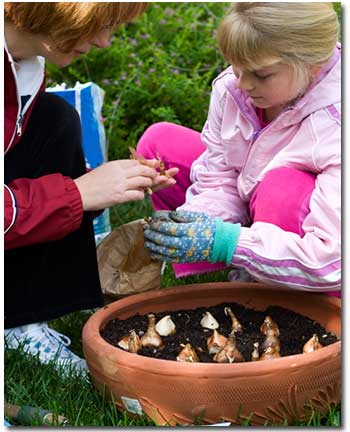Bulb Primer 101

Just as there are seasons for planting particular annuals, perennials or native plants in your zone, varying seasons of blooming plants, and seasons for foliage color changes, there are seasons for planting bulbs and seasons for enjoying the flowers from those bulbs once planted.
When you think of spring, daffodils (Narcissus) come to mind. They weren’t planted in the spring; the narcissus bulbs should have been planted the summer or fall before. Think of summer and you envision the vibrant colors of beautiful dahlias or gladiolas. These bulbs were planted in winter or spring. Our point? To ensure flowers from bulbs in any particular season, their bulb must be planted during the prior season. This gives the bulb time to develop a hardy, healthy root system that will grow a strong plant and produce beautiful flowers.
Different bulbs are planted at different depths. Double check the planting instructions for those you have chosen. Use bulb food and planting mix for happy, healthy plants and flowers.
Did you know that many of the plants we call bulbs aren’t bulbs at all? Read below to find out more.
Bulb Types
A bulb by definition is “a modified underground stem, such as that of the onion or tulip, surrounded by scale-like modified leaves and containing stored food for the undeveloped shoots of the new plant enclosed within.” A second, looser definition is “an underground stem or root such as a corm, rhizome, or tuber.”
Here’s how bulbs differ so you can tell them apart
True Bulb
This is a modified underground leaf bud surrounded by fleshy leaves and with a small stem at the lower end. Picture an onion. We eat the fleshy leaves, but that base with the stringy, dried roots that we cut off, that’s the small stem, compacted. Other bulbs in this category are tulips and daffodils.
Corm
These resemble bulbs but are different because they are made up of all stem cells. Visually, you might not be able to distinguish this difference. They have the same papery leaves coving the outside, and roots at the base. Also, like a bulb, they are a food storage vessel for the plant. After bloom the old corm is used up, but new ones have grown on top or at the sides to take its place. Gladioli, sparaxis, and freesia grow from corms.
Rhizome
Rhizomes are horizontal stems that grow below the ground near the surface. They look like roots, but actually have scale-like leaves and leaf buds at nodes. There are “adventitious” roots growing along these stems, on the underside. Examples are bearded irises and calla lilies. Just to help you understand, other examples of rhizome growers are some grasses and ferns.
Tuber
A thickened stem that runs underground. At the ends of the stolons grows a tuber or a storage chamber that is short, thick, and round. It grows totally or partially underground. Tuberous begonias, cyclamen, and potatoes grow from tubers.
Tuberous Root
Growing underground, this differs from a tuber in that it’s a swollen root rather than a thickened stem. Tuberous roots have growth buds on top in the old stem portion, from which spring the plants. Dahlias and sweet potatoes grow from tuberous roots.











